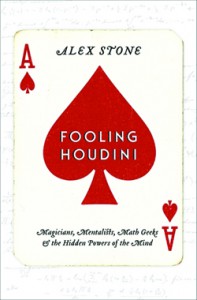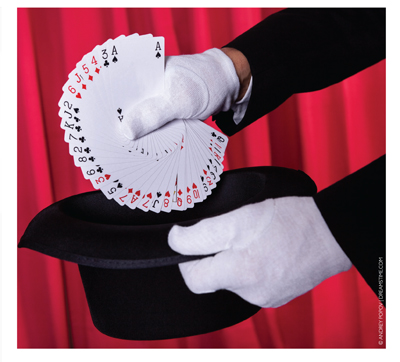Fooling Houdini: Magicians, Mentalists, Math Geeks, and the Hidden Powers of the Mind

Dear reader, this is your lucky day! I can teach you how to steal a watch, cheat at cards, read minds, and astonish friends and strangers. Actually, I can’t teach you any of those things—but I have a treat for you anyway: a book that assays those topics and lots of other tantalizing necromantic antics.
In Stockholm, Sweden, in 2006, Alex Stone participated in the World Championships of Magic, the so-called Magic Olympics. It was a disaster for the poor fellow. He was so bad he was dismissed—cashiered in the middle of his act by a judge. Dorky, depressed, and discombobulated, Stone had two career paths open to him: pursue his magic training or study physics. He enrolled in Columbia University’s physics graduate program, but eventually magic regained its hold on his life and aspirations. (I would have stuck with physics, but hey, I’m the last person who ought to offer career advice to anyone.)
In Fooling Houdini—the title refers to Dai Vernon, a legendary magician who fooled Harry Houdini with the same card trick seven times in a row—Stone details his sorcerer’s apprenticeship, and a bracing journey it is. (I won’t ruin the suspense by revealing whether or not he reached the goal he eventually dedicated himself to after the Stockholm debacle: to become a master conjurer and show off his artistry to his peers at the 2010 International Brotherhood of Magicians’ convention.) Stone might have abandoned a career in science, but science, in effect, didn’t cease pursuing him. As he immersed himself in the theory and practice of becoming a first-class magician, he felt compelled to learn all about the scientific underpinnings of his craft. And so Stone—and his book—explored neuroscience, psychology (“consciousness may well be the greatest magic show of all”), mathematics and, of course, physics (“Magic transports us to an absurd universe, parodying the laws of physics in a whimsical toying of cause and effect”).
I was startled—happily so—by how engrossing the author’s scrutiny of the nexus between magic and science was. That science can illuminate elements of the magician’s trade didn’t come as a great shock; but that magic can elucidate aspects of science did surprise me. Moreover, Stone’s forays into science never seem gratuitous or like attempts to merely pad his book; they’re all relevant to his (and the reader’s) unsentimental education. To cite one example, the author’s discussion of the relationship between shuffling cards and probability theory—a discussion that ranges from information theory to Bell Labs research to entropy—is a tour de force, germane to Stone’s refinement of his skills and both thought-provoking for, and very accessible to, the lay reader. (Fooling Houdini is proof of the belief that the best way to teach science is to embed it in “real life.”)
Expectedly, Stone introduces a number of magicians in Fooling Houdini, but readers expecting to meet a bunch of colorful, weird eccentrics might be disappointed, because the wizards who appear in this book don’t seem much more odd than the scientists Stone describes. Stone’s magic teachers and colleagues are invariably serious professionals: dedicated, diligent, and smart. (I’ve seen some of the magicians mentioned in this book—Jeff McBride, Penn & Teller—perform live. Their superb shows should have made me realize long ago just how conscientious and astute good magicians are.) But just because Fooling Houdini’s magi aren’t wacky, doesn’t mean they aren’t interesting. Take, for instance, Richard Turner, “the greatest living card cheat and quite possibly the sharpest card handler of all time,” according to Stone. Turner happens to be blind, and the book offers persuasive proof that his life and accomplishments are amazing.
Stone devotes a chapter to discussing a subject close to his heart, the moral issues raised by the magician’s techniques. His observations are worth consideration. Ralph Ellison once said in an interview something to the effect that “Craft, to me, is an aspect of morality” (a sentiment I’m quite sympathetic toward), but Stone is interested in something else. He’s concerned with the morality of many magicians’ passion for keeping their methodology as secret as possible. Stone’s uneasiness with this secrecy led to his being mauled for his stance; after writing an article for Harper’s magazine exposing the modus operandi behind some magic tricks, he caught hell from the magic establishment. The experience seemed to confirm for him that disclosing the mechanics that make conjuring possible is good for both magicians and the public: “I don’t think it’s any coincidence that the golden age of stage magic [the late nineteenth and early twentieth centuries] was also the golden age of exposures, because exposure drives innovation. Much in the way that market-oriented competition among businesses fosters economic growth by forcing companies to evolve, exposure compels magicians to modernize their acts and invent new material. Secrecy, meanwhile, is a license to be lazy. Like monopolies in the marketplace, it breeds stagnation.”
 Now I happen to be the perfect patsy for magicians—I never figure out how they pull off their tricks—but nevertheless, I disagree with Stone; I don’t want to know how they do what they do. (I’ll try to forget what I learned from Fooling Houdini.) As Stone himself says at the end of his book, “As fun as it is to fool people, it’s just as fun—more so, even—to be fooled.” Surely an understanding of the craft that makes magic acts possible can only diminish an audience’s pleasure. I’m aware that Penn & Teller have had a very successful career as exponents and professional incarnations of Stone’s point of view. But even Stone acknowledges that there is a lot more to their act—sly complexity, teasing trickery, wit—than merely revealing the “truth” behind their performance. (I might add that the artist’s investigation of, and commenting on, his artifice has been popular in many artistic fields in the last few decades; the phenomenon is very much a part of postmodernist palaver. There is, for instance, John Barth’s Chimera, a monumental, maddening bore by an otherwise good writer.)
Now I happen to be the perfect patsy for magicians—I never figure out how they pull off their tricks—but nevertheless, I disagree with Stone; I don’t want to know how they do what they do. (I’ll try to forget what I learned from Fooling Houdini.) As Stone himself says at the end of his book, “As fun as it is to fool people, it’s just as fun—more so, even—to be fooled.” Surely an understanding of the craft that makes magic acts possible can only diminish an audience’s pleasure. I’m aware that Penn & Teller have had a very successful career as exponents and professional incarnations of Stone’s point of view. But even Stone acknowledges that there is a lot more to their act—sly complexity, teasing trickery, wit—than merely revealing the “truth” behind their performance. (I might add that the artist’s investigation of, and commenting on, his artifice has been popular in many artistic fields in the last few decades; the phenomenon is very much a part of postmodernist palaver. There is, for instance, John Barth’s Chimera, a monumental, maddening bore by an otherwise good writer.)
I spotted two spelling mistakes in Fooling Houdini and a few grammatical miscues (I don’t expect anything good to come from a publisher’s copy-editing and proofreading anymore, but surely Stone, who obtained his BA from Harvard, should know that anyone is a singular pronoun). I also wish that Stone had devoted more space to two topics: examining Uri Geller and the other charlatans who insist that their mountebankery has paranormal or supernatural origins; and the roles of magic and magicians in the other arts. Those are really my only complaints about this book. Fooling Houdini is very well written, fascinating, and fun. Fortuitously encountering a good book to review makes the critic’s job a pleasurable one; that’s what happened with me and Fooling Houdini.![]()
